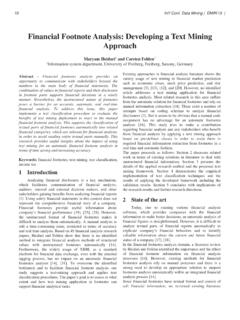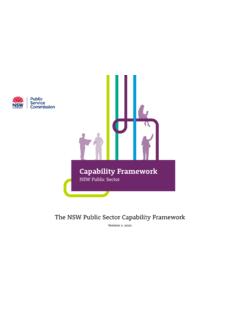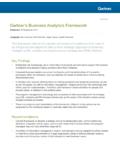Transcription of Advanced Framework for Simulation, Integration and ...
1 DISTRIBUTION STATEMENT A. Approved for public release; distribution is Framework for Simulation, Integration and Modeling (AFSIM)(Case Number: 88 ABW-2015-2258)Peter D Clive*, Jeffrey A Johnson*, Michael J Moss*,James M Zeh , Brian M Birkmire , and Douglas D Hodson *The Boeing CompanySt. Louis, MO Aerospace Systems DirectorateAir Force Research LaboratoryWright Patterson Air Force Base, OH Computer Science and Engineering DepartmentAir Force Institute of Technology, USAA bstract The Advanced Framework for Simulation, Integration and Modeling (AFSIM) is an engagement and mission level simulation environment written in C++ originally developed by Boeing and now managed by the Air Force Research Laboratory (AFRL). AFSIM was developed to address analysis capability shortcomings in existing legacy simulation environments as well as to provide an environment built with more modern programming paradigms in mind.
2 AFSIM can simulate missions from subsurface to space and across multiple levels of model fidelity. The AFSIM environment consists of three pieces of software: the Framework itself which provides the backbone for defining platforms and interactions, an integrated development environment (IDE) for scenario creation and scripting, and a visualization tool called VESPA. AFSIM also provides a flexible and easy to use agent modeling architecture which utilizes behavior trees and hierarchical tasking called theReactive Integrated Planning aRchitecture (RIPR). AFSIM is currently ITAR restricted and AFRL only distributes AFSIM within the DoD community. However, work is under way to modify the base architecture facilitating the maintenance of AFSIM versions across multiple levels of Terms Simulation Framework , Mission Level Model, Artificial Intelligence Framework , Agent FrameworkI.
3 INTRODUCTIONAFSIM is a government-approved C++ simulation Framework for use in constructing engagement and mission-level analytic simulations for the Operations Analysis community, as well as virtual experimentation. The primary goal of AFSIM applications is the assessment of new system concepts and designs with Advanced capabilities not easily assessed within traditional engagement and mission level simulations. Development activities include modeling weapon kinematics, sensor systems, electronic warfare systems, communication networks, Advanced tracking, correlation, and fusion algorithms, and automated tactics and battle management this section, the reasons for the development and history of AFSIM are presented. The next section provides an overview of the AFSIM architecture, integrated development environment, visualization tools and AFSIM s agent modeling architecture.
4 The following section highlights the current/planned effort to create a Component BasedArchitecture for AFSIM which will allow multiple levels of releasability. The last section provides a conclusion on AFSIM and its current BackgroundAFSIM is based on The Boeing Company s Analytic Framework for Network-Enabled Systems (AFNES). Under contract, Boeing delivered AFNES to the Air Force (specifically AFRL/RQQD) with unlimited rights, including source code, in February 2013. AFRL/RQQD rebranded AFNES as AFSIM and has begun to distribute AFSIM within the Air Force and DoD, including DoD Boeing Company developed and funded the AFNES simulation Framework through internal research and development (IR&D) funding from 2003-2014. Beginning in 2005, Boeing began developing a customized AFNES capability to simulate threat Integrated Air Defense Systems (IADS) to assess Advanced air vehicle concepts performing Precision Engagement missions.
5 The requirements of this new IADS simulation capability included being able to match results with the Air Force-approved mission level model. The reason for developing an AFNES alternative to the Air Force IADS modeling capability relates to the limitations associated with the Air Force mission level model. Examples of areas in which the Air Force mission level model is lacking include: expansion of representations of Electronic Warfare (EW) techniques; the Integration of independent tracking and correlation systems; utilization of vendor-supplied auto-routers and mission optimization capabilities; net-centric communications systems; the contribution of Space assets; and Integration of special, existing models, such as AGI s System Tool Kit (STK).The AFNES IADS capability became operational in 2008, and is currently being utilized by multiple Boeing development programs, as well as government contracted programs, to assess the ability of Advanced air vehicle design concepts to Int'l Conf.
6 Scientific Computing | CSC'15 |73 DISTRIBUTION STATEMENT A. Approved for public release; distribution is Advanced Air Defense networks and conduct precision engagement missions. In 2010, the AFRL/RQQD Aerospace Vehicles Technology Assessment & Simulation (AVTAS) Lab (formerly AFRL/RBCD) commissioned a trade study of M&S Frameworks for the purpose of assessing potential alternatives to replace or augment their current constructive simulation environment. The result of the AFRL trade study was the selection of AFNES as the best M&S Framework to meet their air vehicle mission effectiveness analysis AFSIMSOFTWARE SUITEThe AFSIM software suite consists of three distinct pieces or applications. The first piece is the Framework itself which provides the underlying architecture and services allowing the creation of simulation applications.
7 The second piece is the integrated development environment (IDE) which facilitatesthe creation of scenarios. Lastly the Visualization Environment for Scenario, Preparation and Analysis (VESPA) application allows for post-processing and visualization of scenario executions. This section provides detail on all Functional ArchitectureAFSIM is an object-oriented, C++ simulation environment that facilitates the prototyping of customized engagement and mission level warfare simulations. AFSIM includes a set of software libraries, shown as a functional architecture in Figure 1, containing routines commonly used to create analytic applications. The AFSIM infrastructure includes routines for the top-level control and management of the simulation; management of time and events within the simulation; management of terrain databases; general purpose math and coordinate transformation utilities; and support of standard simulation interfaces, such as those supporting the Distributed Interactive Simulation (DIS) protocol.
8 The AFSIM componentsoftware routines support the definition of entities (platforms) to populate scenarios. These software routines contain models for a variety of user-defined movers, sensors, weapons, processors for defining system behavior and information flow, communications and track top-level characteristics and capabilities of the AFSIM Framework include:xA class hierarchy of simulation objects, including data driven platforms, movers, sensors, communications networks, processors, weapons, and simulation and Event classes to control time and/or event processing for AFSIM-based models, and the logging of entity math libraries for coordinate systems (WGS-84, Spherical, ENU, NED), random number generation, DIS communication, High-Level Architecture (HLA) publish and subscribe, and generalized software routines, such as container classes for storing objects and common geo-spatial environment and terrain representation, importing standard formats such as National Geospatial-Intelligence Agency (NGA) Digital Terrain Elevation Data (DTED)
9 , ESRI, GeoTiff and VMAP database general-purpose scripting language to provide access to Framework objects using text input files ( , scripts) rather than through the Application Programming Interface (API).xCommunications network modeling, including basic radio transceivers and Advanced communications algorithms, including addressable nodes, routers, multi-access protocols, contention and warfare modeling, including noise and deceptive jamming techniques, as well as the ability to jam and degrade any type of electro-magnetic receiver, including communications of information flow and tasking between player and system elements to define candidate Network Centric Operation (NCO) ability to run any AFSIM application in both constructive (batch processing) and virtual (real-time) interface elements for integrated scenario generation and post-processor visualization addition to the AFSIM core, several capabilities are available.
10 Additional capabilities include: multitarget tracking algorithms; Link-16 modeling of both the physical and message layers; and Reactive Integrated Planning aRchitecture (RIPR) intelligent agent algorithms for implementing complex object behaviors. RIPR utilizes a Boeing-developed Quantum Tasker concept for commander subordinate interaction and task de-confliction. Section 3 provides additional details of the RIPR model. Restricted capabilities include missile flyout baseline AFSIM constructive application is called the Simulation of Autonomously Generated Entities (SAGE), which was one of the first constructive applications developed using the AFSIM Framework . SAGE is a simple application that reads in a user-defined input file, executes the simulation, and outputs any user-defined data files. The original purpose Fig.








